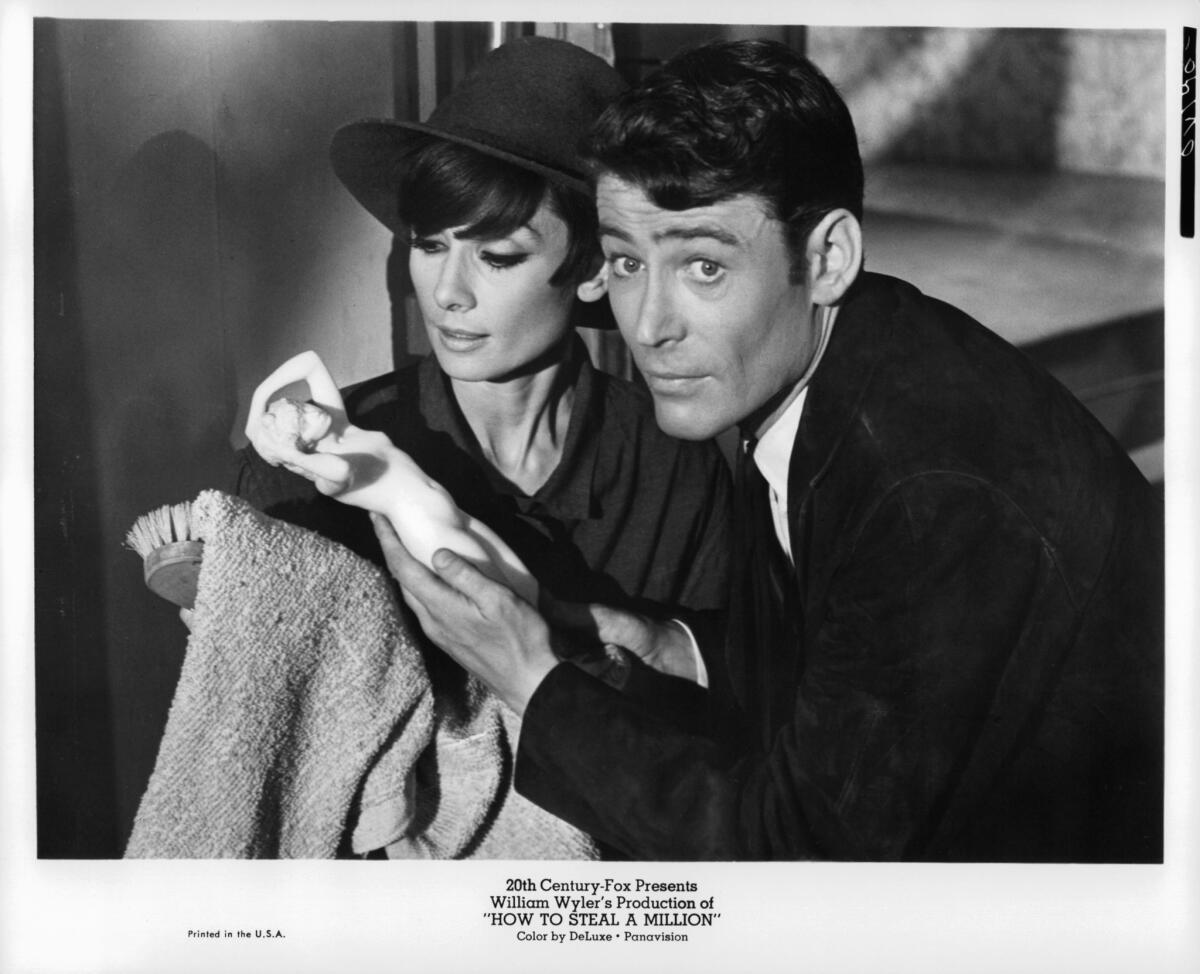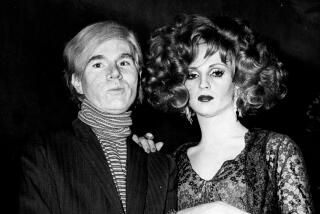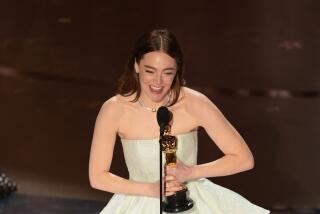From the Archives: Audrey Hepburn, Actress and Humanitarian, Dies
Audrey Hepburn, the slender, doe-eyed Oscar-winning actress who enchanted moviegoers in such films as “Roman Holiday” and “Breakfast at Tiffany’s” and in later years dedicated herself to feeding the world’s hungry, died Wednesday of colon cancer.
She was 63 and died at her home in Tolochenaz, a lakeside village about 15 miles from Lausanne, Switzerland, where she had returned after intestinal surgery in November at Cedars-Sinai Medical Center in Los Angeles.
At the time, doctors were quoted as saying they expected a full recovery.
The death of the aristocratic, gamin-like star, who had long been a goodwill ambassador for the United Nations, was announced by a U.N. spokesman in New York.
She will be buried Sunday at the village church in Tolochenaz.
If Miss Hepburn sometimes found herself in Cinderella roles, the shoe fit. The sickly, scrawny teen-ager who suffered from malnutrition during World War II in Nazi-occupied Holland emerged in the 1950s as one of Hollywood’s premier leading ladies, known for a persona that somehow blended sleek European sophistication and a vulnerable, waif-like innocence. Among her other films were “War and Peace,” “Funny Face,” “The Nun’s Story,” “Charade,” “My Fair Lady” and “Wait Until Dark.”
In her later years, she was more than just a pretty figurehead for the United Nations International Children’s Emergency Fund (UNICEF). Devoting herself to the role of goodwill ambassador in 1988, Miss Hepburn used her star appeal to raise a fortune for the charity and personally helped deliver aid to children in such disparate places as Ethiopia, Sudan, Guatemala, Venezuela, Bangladesh and Vietnam.
Last year she visited war-torn Somalia in a trip that helped focus world attention on the plight of starving children in that African nation.
Her death “is a painful and irreplaceable loss for her family, friends, for children everywhere and UNICEF,” said UNICEF director James Grant.
In 1991, after traveling with her to Ethiopia, Grant told an interviewer that “what you see in Audrey Hepburn is exactly what you get. There is no public or private persona. She is what she seems to be. It may sound boring, but Audrey is one of the most special human beings I’ve ever met in my entire life.”
Born Edda van Heemstra Hepburn-Ruston in Brussels to a Dutch noblewoman and British banker, Miss Hepburn seemed destined to a life of privilege. As a child she attended a private school in Great Britain but, after her parents’ divorce, returned to live with her mother in The Netherlands. Fate had placed her in the path of history.
During five years of Nazi occupation, Miss Hepburn tried to lead a normal life in a family that suffered greatly. The Nazis executed her uncle and a cousin of her mother because of their efforts in the resistance movement, and placed her brother in a labor camp. “There was always a cloud of fear and repression,” she said years later.
Like many children, Miss Hepburn suffered malnutrition because of food shortages--her family ultimately surviving on flour made from tulip bulbs. When she wasn’t dreaming of becoming a ballerina, Miss Hepburn said later, she and her friends would dream of the food they would eat when the war was over.
When Holland was liberated, relief trucks were one step behind. But malnutrition had left Miss Hepburn, then 16, suffering from acute anemia, respiratory problems and edema--swelling of the limbs. But her spirit, the joie de vivre that would come across in her films, was intact.
“As long as he has the minimum,” Miss Hepburn once explained, “a child is perfectly cheerful. I remember having lots of fun. We didn’t just sit on the floor for five years and cry.”
After the war’s end, Miss Hepburn returned to London on a ballet scholarship, thanks to her early training. She pursued a dance career in nightclubs and West End revues and picked up odd modeling jobs and bit parts in British films.
Her storybook break came in 1951. She had a bit part in the forgettable “Monte Carlo Baby,” being filmed on the French Riviera, when the French novelist Colette, then 78, picked her out of a crowd and declared she had found the perfect actress for a Broadway adaptation of one of her stories.
“My dear,” Colette is said to have told her, “I have just cabled New York to tell them to stop looking for a Gigi. I have found her.”
“I’m sorry, madame,” Miss Hepburn responded, “but I can’t act.”
Off to America she went. She took a crash course in acting but proved so green that “Gigi” producer Gilbert Miller, only days before the play’s premiere in Philadelphia, considered dropping her in favor of an experienced actress. But he didn’t, and soon Miss Hepburn was being hailed as the freshest face on Broadway--”as fresh and frisky as a puppy out of a tub,” declared New York Times critic Walter Kerr.
Film director William Wyler requested her for “Roman Holiday,” his 1953 romance about a lonely young princess who, trying to hide her true identity, finds 24 hours of happiness with an American newspaperman played by Gregory Peck. Critic Bosley Crowther described her as “a slender, elfin and wistful beauty, alternately real and childlike in her profound appreciation of newly found, simple pleasures and love.” Her melodic, hard-to-place accent and haunting beauty captivated audiences and helped win her the Academy Award as best actress. In her career she earned four other Oscar nominations.
She returned to Broadway raves in “Ondine,” for which she won a Tony award, and went on to make 20 films in a 13-year period. In an era of such curvaceous bombshells as Marilyn Monroe, Elizabeth Taylor and Sophia Loren, the 5-foot, 7-inch, 110-pound Hepburn was a fragile swan who typically captivated older leading men--father figures, it could be said--more with an irresistible spirit rather than sex appeal.
Often, she was cast in Cinderella-like roles. In Billy Wilder’s “Sabrina” (1954), she was the chauffeur’s daughter who, recently returned from cooking school, attracts the attentions of the two heirs of the family fortune, played by William Holden and Humphrey Bogart. In Stanley Donen’s “Funny Face” (1957), she was the mousy bookworm discovered by a fashion photographer (played by Fred Astaire) and transformed into a high-fashion butterfly. In Billy Wilder’s “Love in the Afternoon,” she was an 18-year-old who domesticates playboy Gary Cooper, with Maurice Chevalier as her concerned father. And in George Cukor’s “My Fair Lady” (1964), she’s the Cockney flower girl Eliza Doolittle who becomes a sophisticate under the tutelage of Rex Harrison’s Prof. Henry Higgins.

Audrey Hepburn and Peter O’Toole in “How To Steal A Million.”
Her versatility as an actress was tested by such diverse roles as Natasha in “War and Peace” (1956), opposite then-husband Mel Ferrer; as Rima the Bird Girl in “Green Mansions,” an ethereal work directed by Ferrer; in the title role in “The Nun’s Story” (1959), a true tale of a sister who renounces her vows while nursing in the Congo during World War II and returns to Belgium to work for the Resistance; as kooky female gigolo Holly Golightly in Blake Edwards’ quirky “Breakfast at Tiffany’s” (1961), and as a blind woman terrorized by criminals in the thriller “Wait Until Dark” (1967). After that film, she went into semi-retirement, taking only one leading part, opposite Sean Connery in “Robin and Marian” (1976), as the aging couple of the Robin Hood story.
Miss Hepburn also distinguished herself from other actresses of her era by becoming an icon of haute couture and a regular on the best-dressed lists, modeling evening gowns by designer Hubert de Givenchy. When Jackie Kennedy brought high fashion to the White House, it was evident that her style had been influenced by Miss Hepburn.
After “Wait Until Dark,” Miss Hepburn stayed home in Switzerland raising her family. She had a son, Sean, by Ferrer in 1960. After their divorce in 1968, she married Italian psychiatrist Andrea Dotti and had a second son, Luca. That marriage also ended in divorce. Since 1970, Miss Hepburn had lived with Robert Wolders, a former actor and the widower of actress Merle Oberon.
She surfaced briefly last year to be a tour guide for “Gardens of the World With Audrey Hepburn,” a six-part PBS series that begins tonight at 8 on KCET, Channel 28.
She was too ill this month to travel to Los Angeles to accept a Screen Actors Guild honor but sent a message thanking all her directors and co-stars.
“It is they,” she said, “who helped and honed, triggered and taught, pushed and pulled, dressed and photographed, and with endless patience, and kindness . . . guided and nurtured a totally unknown, insecure, inexperienced, skinny broad into a marketable commodity.”
In what proved to be a final tribute, the Academy of Motion Picture Arts and Sciences announced it had given its Jean Hersholt Humanitarian Award to Miss Hepburn and Taylor.
An Academy spokesman said Wednesday that the award will be made posthumously at the Oscar ceremony March 29.
As a young actress, one role that Miss Hepburn was reportedly offered, but turned down, was the lead in an adaptation of “The Diary of Anne Frank,” the true story of a Jewish girl whose family lived in hiding during the Nazi occupation of Holland, where Miss Hepburn had witnessed the horror on the streets. Years later she told an interviewer that the idea of playing Anne Frank overwhelmed her because she felt too much kinship with the girl whose family was ultimately discovered and killed by the Nazis.
“I was exactly the same age as Anne Frank. We were both 10 when war broke out. . . . I was given the book in Dutch, in galley form, in 1946 by a friend. I read it . . . and it destroyed me,” she told Lesley Garner of the London Sunday Telegraph in a 1991 interview.
“I have memories. More than once I was at the station seeing trainloads of Jews being transported, seeing all these faces over the top of the wagon. . . . We saw reprisals. We saw young men put against the wall and shot, and they’d close the street and then open it and you could pass by again. If you read the diary, I’ve marked one place where she says, ‘Five hostages shot today.’ That was the day my uncle was shot.
“And in this child’s words I was reading about what was inside me and is still there. It was a catharsis for me. This child who was locked up in four walls had written a full report of everything I’d experienced and felt.”
But decades later, Miss Hepburn did help tell Anne Frank’s story, serving as narrator in a special concert tour of the London Symphony Orchestra to raise funds for UNICEF. For Miss Hepburn, the role of humanitarian seemed to come naturally.
Sometimes she would tell about her visit to a remote region of the Sudan where she saw a sick 14-year-old boy lying on a dirt floor and asked the doctor what was wrong with him. The diagnosis was familiar: acute anemia, respiratory problems and edema, all brought on by malnutrition.
“That was exactly the same way I finished the war--that age, with those three things,” she told Garner. “And I thought, how strange to hear those same three things.
“And it was also a moment of glory for me, because just then a big UNICEF truck came by full of lots of food and lots of medicine.”
The Roles of Audrey Hepburn
Actress Audrey Hepburn, who died Wednesday at the age of 63, made her first film in 1948 and won an Oscar for best actress in 1953 for “Roman Holiday.”
Films
“Dutch in 7 Lessons,” 1948.
“One Wild Oat,” 1951.
“Young Wives’ Tale,” 1951.
“Laughter in Paradise,” 1951.
“Lavender Hill Mob,” 1951.
“Monte Carlo Baby,” 1951.
“The Secret People,” 1952.
“Roman Holiday,” 1953.
“Sabrina,” 1954.
“War and Peace,” 1956.
“Funny Face,” 1957.
“Love in the Afternoon,” 1957.
“Green Mansions,” 1959.
“The Nun’s Story,” 1959.
“The Unforgiven,” 1960.
“Breakfast at Tiffany’s,” 1961.
“The Children’s Hour,” 1962.
“Charade,” 1963.
“Paris When It Sizzles,” 1964.
“My Fair Lady,” 1964.
“How to Steal a Million,” 1966.
“Two for the Road,” 1967.
“Wait Until Dark,” 1967.
“Robin and Marian,” 1976.
“Bloodline,” 1979.
“They All Laughed,” 1981.
“Love Among Thieves,” 1986 (for television).
“Always,” 1989.
Plays
“Gigi,” 1951.
“Ondine,” 1954.
Toshiro Mifune, Acclaimed Japanese Film Star, Dies
Doris Lessing dies at 94; British novelist of the ‘female experience’
Bette Davis Dies in Paris at 81
Nat ‘King’ Cole dies of cancer at 45
Simon Wiesenthal dies at 96; Nazi hunter loyal to the dead
More to Read
Start your day right
Sign up for Essential California for the L.A. Times biggest news, features and recommendations in your inbox six days a week.
You may occasionally receive promotional content from the Los Angeles Times.






